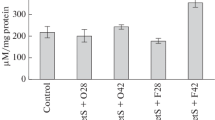Summary
In blood samples of 54 obese persons (13 men, 41 women) some lipid components, malondialdehyde (MDA), and the activities of free radical protecting enzymes superoxide-dismutase (SOD) and glutathione-peroxidase (GSHpx), were determined before and after a seven-day slimming diet of 2.1 MJ/day.
Body weight, triglycerides, HDL-cholesterol, and HDL-3-cholesterol all decreased, total cholesterol increased after the seven days hospitalization. After continuing the slimming diet (5.0–6.3 MJ/day) at home, HDL-2-cholesterol increased and total cholesterol returned to the initial value after three months.
MDA decreased in the groups of hyperlipoproteinemia II/a and II/b and also in the group with high cholesterol and triglyceride levels (above 5.7 and 2.7 mmol/l). Correlation coefficients refer to the dominant role of high TG in the intensity of lipid peroxidation.
The activity of SOD fell after the slimming, independent of lipid parameters. GSHpx activity remained unchanged except a drop in the male participants having high cholesterol levels. The behavior of the free radical protecting enzymes needs further examination.
Zusammenfassung
Es wurden vor und nach einer 7tägigen Entfettungskur (2,1 MJ/Tag) von 54 Fettsüchtigen stammende Blutproben auf einige Lipidkomponenten (Malondialdehyd [MDA] und die Aktivität der vor freien Radikalen schützenden Enzyme Superoxid-Dismutase [SOD] und Glutathionperoxidase [GSHpx]) untersucht.
Nach 7tägiger Krankenhausbehandlung wurde eine Erniedrigung des Körpergeichts, der Triglyceride, des HDL-Cholesterin- und des HDL-3-Cholesterins sowie eine Zunahme von Gesamtcholesterin festgestellt. Nach einer zu Hause fortgesetzten drei Monate dauernden Kur (5,0–6,3 MJ) wurde eine Zunahme von HDL-2-Cholesterin und ein Rückgang von Gesamtcholesterin auf den Ausgangswert beobachtet.
Bei an Hyperlipoproteinämie leidenden Vpn. und auch bei denen, die einen erhöhten Cholesterin- und Triglyceridgehalt aufwiesen, wurde eine höhere MDA-Konzentration festgestellt.
Nach der Entfettungskur, unabhängig von den Lipiden, fällt die SOD-Aktivität. Die GSHpx-Aktivität ist unverändert, ausgenommen bei Männern mit hohem Cholesterinniveau.
Weitere Untersuchungen über die vor freien Radikalen schützenden Enzyme sind erforderlich.
Similar content being viewed by others
References
Boehringer Mannheim GmbH, Wahlefeld AW (1983) Triglyceride test collection. Diagnostica (December)
Dworschák E, Bíro G, Pados G, Horváth M, Lugasi A, Zsinka Á (1987) Lipid characteristics and malondialdehyde level in the sera of obese people. Z Ernährungswiss 26:165:170
Fredrickson DD, Lees RS (1965) System for phenotyping of hyperlipoproteinemia. Circulation 31:321–331
Gidez LI (1982) Precipitation methods in lipoprotein diagnosis. J Lipid Res 23:1206–1223
Gödecke Labordiagnostica (1984) EnzaChol®-F. Direction for use enclosed to the kit
Koizumi A, Weindruch R, Walford RL (1987) Influences of dietary restriction and age on liver enzyme activities and lipid peroxidation in mice. J Nutr 117:361–367
Loper-Vivella MF, Stone TG, Ellis FS, Collwell JA (1977) Cholesterol determination in high density-lipoproteins separated by three different methods. Clin Chem 23:882–884
Magnoni V, Barbieri C, Piepoli V, Pissaia L, Rauche WG, Zanosi S (1981) Changes in high-density lipoprotein cholesterol and other lipids in plasma of obese patients during treatment by diet. Boll Soc Ital Speriment 57:18–21
Nicolai A, Gratti S, Svegliatti A, Baroni A (1985) Changes in lipid profile and blood insulin after a diet low in energy. Clinica Dietologica 12:555–564
Noguchi T, Cantor AH, Scott ML (1973) Mode of action of selenium and Vitamin E in prevention of exudative diathesis in chicks. J Nutr 103:1502–1511
O'Brien PJ (1980) Intracellular mechanism for lipid peroxide decomposition. In: Simic MG, Karel M (eds) Antioxidation in food and biological systems. Plenum press, pp 563–587
Ohkawa H, Ohishi N, Yagi K (1979) Assay for lipid peroxides in animal tissues by thiobarbituric acid reaction. Anal Biochem 95:351–358
Winterbourn CC, Hawkins RE, Brian M, Carrell RW (1975) The estimation of red cell superoxide dismutase. J Lab Clin Med 85:337–341
Author information
Authors and Affiliations
Rights and permissions
About this article
Cite this article
Dworschák, E., Lugasi, A., Pados, G. et al. Changes of some lipid and lipid peroxidation characteristics in obese people as a result of a low energy diet. Z Ernährungswiss 27, 207–215 (1988). https://doi.org/10.1007/BF02019508
Received:
Published:
Issue Date:
DOI: https://doi.org/10.1007/BF02019508



